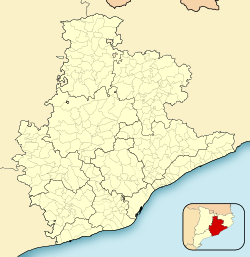Santa Coloma de Gramenet
Santa Coloma de Gramenet
| |
|---|---|
 Town Hall | |
| Coordinates: 41°27′14″N 2°12′40″E / 41.454°N 2.211°E | |
| Country | |
| Community | |
| Province | Barcelona |
| Comarca | Barcelonès |
| Government | |
| • Mayor | Núria Parlón Gil (2015)[1] (PSC) |
| Area | |
| • Total | 7.0 km2 (2.7 sq mi) |
| Elevation | 56 m (184 ft) |
| Population (2014)[1] | |
| • Total | 118,738 |
| • Density | 17,000/km2 (44,000/sq mi) |
| Demonym(s) | Colomenc (ca) Colomense (es) |
| Website | www |
Santa Coloma de Gramenet (Catalan pronunciation: [ˈsantə kuˈlomə ðə ɣɾəməˈnɛt]; Spanish: Santa Coloma de Gramanet), informally simply known as Santa Coloma (historically also known as Gramenet de Besòs) is a municipality in Catalonia, Spain. It is essentially a suburb of Barcelona. It is situated on the south-east side of the Litoral range, with the Puig Castellar (299 m) as its highest point, on the left bank of the Besòs river: the municipalities of Sant Adrià de Besòs and Badalona separate it from the coast.
The area has been inhabited since at least the Iberic period, and the remains of an Iberic village have been found on Puig Castellar. The artefacts are housed in a museum in La Torre Balldovina, a building dating from the 18th century. Other notable buildings include the renaissance palace of La Torre Pallaresa and the noucentista Clínica Mental.
In November 2008, the city made worldwide news by installing solar panels on top of crypts in the local cemetery, in an effort to help fight climate change.[3]
Transport
References
- Panareda Clopés, Josep Maria; Rios Calvet, Jaume; Rabella Vives, Josep Maria (1989). Guia de Catalunya, Barcelona:Caixa de Catalunya. ISBN 84-87135-01-3 (Spanish). ISBN 84-87135-02-1 (Catalan).
- ^ a b "Ajuntament de Santa Coloma de Gramenet". Generalitat of Catalonia. Retrieved 2015-11-13.
- ^ "El municipi en xifres: Santa Coloma de Gramenet". Statistical Institute of Catalonia. Retrieved 2015-11-23.
- ^ http://news.bbc.co.uk/1/hi/world/europe/7745673.stm
External links





